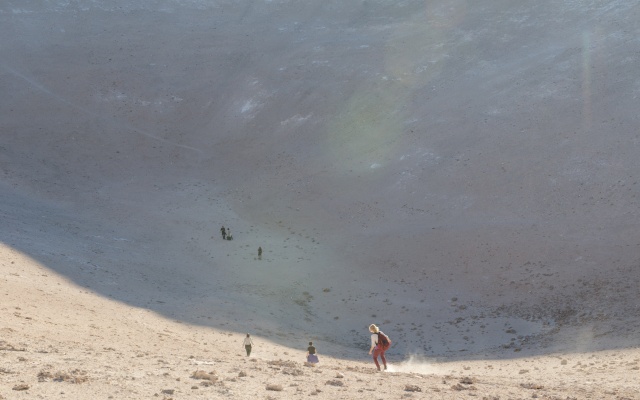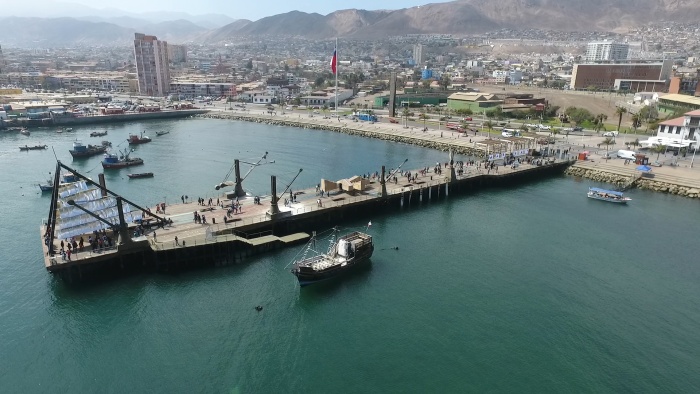
SACO6, Festiwal Sztuki Współczesnej w Antofagaście, Chile. Historyczne molo, 2017. (c) SACO
My work table is covered with papers, many of them related to Latin American art and some notes commenting on the existing relationship between art, context, and environment.
Confronting all this I wonder again, almost obstinately, about art in the region: would it be possible to think of its aesthetic manifestations while eluding to the tension engendered by certain topics; and dodging, at the same time, the link between that production and the artist and her contingencies? These questions have been generally associated with the Latin American geopolitical reality, in the context of a post-colonial process; a process which in spite of the declarations of independence, remains economically, financially, and culturally, and therefore politically, subordinated to the hegemonic power.
Indeed, our current art system was configured during colonial times, forged in a process of re-acculturation that established taste in accordance with European standards and the tenets of modernity. As asserted by Santiago Castro Gómez, many institutions, especially in the official fields of education and culture, reproduced the model both in terms of disciplinary thought and of the tree-like organization of its structures. Inscribing such a model in what we can call the triangular structure of colonialism, consisting of: coloniality of being, coloniality of power, and coloniality of knowledge.
It is logical, then, that regional art, in that binomial consisting of art and politics, has set its focus on a double articulation: to rethink its belonging to that dominant culture and, at the same time, to interpolate power.
Due to that stance, it is also reasonable that it is interested in contextual and environmental issues, that were soon incorporated as the global community became aware of the damage caused by the industrial revolution, and that it did from its own historical perspective.
Thus, we can identify the first records of conceptual art in its local versions and we cannot avoid mentioning the Arte de Sistemas (Systems Art, CAYC) in Argentine and Arte Antropofágico (Anthropophagic Art) in Brazil. And how can we not mention at least Nicolás García Uriburu (Argentina) and Tropicália (1967) by Hélio Oiticica (Brazil), just to name a few.
Today, we see that the artistic manifestations of militant aesthetics, typical of the seventies, have updated their repertoires and then began to include environmental and gender issues.
Another noteworthy aspect, as a regional phenomenon, is the emergence of a significant number of projects that are self-managed by the artists themselves, as a response to the withdrawal of the state that is typical of neoliberal governments. This way, artists’ collectives are organized for the production of works and theory. I am talking about projects such as Plataforma Caníbal of the Fundación Divulgar, led by Jaider Orsini in Barranquilla (Colombia), or the case of the Museo de Barrio with its Project Resonances, versions of water curated by Luis Fernando Arango Duarte (Manizales, Colombia); Organic Economies, Nature, artificiality and resistance proposed by La Paternal Espacio Proyecto (Argentina). On the other hand, artists’ collectives in Bolivia are concentrating their attention on two major issues: the exploitation of the TIPNIS (Isiboro Sécure National Park and Indigenous Territory) and mining extractivism. On the other hand, in Argentina, it is relevant that a specific space was created for these issues: the Art and Ecology Biennial in Mendoza (2016). Projects that promote change in a broad sense of the terms “context” or “environment,” for they have an impact on the very contextual conditions of production and they also critically intervene on their habitat, in short, on the environment.
In this context, we find the work of Dagmara Wyskiel, whose oeuvre overflows her own artistic production into management and curatorship, and she does this from a contextual political vision (although she does not agree with such a description) which aims to the construction of a scene and to put Antofagasta on the map of the Chilean art world.
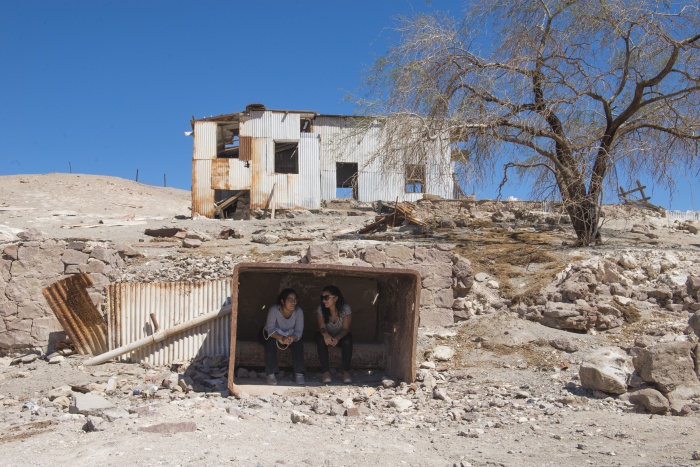
Badanie terenowe z uczestnikami SACO6, Quillagua, ruiny elektrowni wodnej Sloman, 2017. (c) SACO
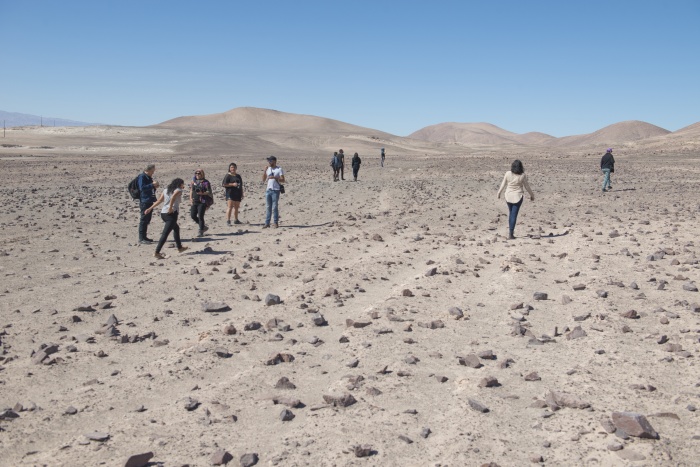
Badanie terenowe z uczestnikami SACO6, Quillagua, teren geoglifów Chug Chug, 2017. (c) SACO
Marcos Figueroa: How are you, Dagmara? First, I would like to ask you how a young Pole, who settled down in Chile, began and developed this history of mixing artistic production, management, and curatorship. Perhaps a sort of brief overview would be useful here, a timeline that could give us a sense of your work.
Dagmara Wyskiel: I arrived in Antofagasta in 2001. I began searching for spaces, people, and historical accounts related to art. And I realized I had landed on the moon, in several aspects, because of how far away I was from any other cultural center and for the nudity of the landscape, and the amazing sky over it.
Nothingness with a capital N. The multiple abandonment of a large territory, reduced to its extractivist role and anesthetized for decades by consumerism, corresponding to a historical chain where only the object of global desire changes: guano, saltpeter, copper, lithium. The system, based in market indexes, in addition to the blackout induced by the dictatorship and from which it never recovered, has left the domain of art outside of the relevant elements of civic life.
Initially, with the SE VENDE (FOR SALE) collective in 2004, we provoked an initial displacement of the public towards objectual, conceptual, experimental, and ephemeral practices. The first collective interventions were located in buildings that were meaningful for the city, destined for culture, architectonic heritage, or in the streets.
With Another Country I and II, two exhibitions held in 2005 and 2007, we invited local artists in Santiago and Valdivia, respectively, and we also set up a platform for network building and experimentation away from the regional margins, situating the art of the Great North in zones far away from the national territory. Hence the euphemism “another country,” to highlight Antofagasta’s isolation.
In 2009 I worked as an editor, together with Christian Núñez as field producer, in the Chile Triennial, an event with which the country inaugurated the commemoration of the Bicentennial. One of the goals of the contemporary art gathering was precisely to strengthen and provide dynamism to the regional scenes.
Later, the Cápsulas de formación (Education Capsules) became clinics that resulted in a significant number of cultural events. It was an alternative program for the professionalization of emergent artists. By the end of 2011, we put out a call for young creators to participate in a workshop for the research, analysis, and production of works. The conviction and commitment of those young artists made this project possible, which inaugurated a school without school.
I think that was the moment when we understood that decentralization is achieved by executing our own ideas, by first of all doing our homework after studying and investigating, and then getting to work with no mimicry. One must decentralize oneself, not wait for someone to decentralize you. Because expecting this type of dehierarchization from the top down, is typical of Latin American provinces, and a symptom of subordination. Like when a teenager asks permission to be independent. There is no other way than that of empowering oneself regarding one’s own history and taking charge, even if the context seems unfair and unfavorable.
In 2012, we invited Fernando Prats for an extreme internship at the driest place in the world, a limited experience because of the disconnection, absorption, and resignification of contextual elements that it demanded. Prats’ stay in Quillagua, an Aymara settlement located about 280 kilometers northeast of Antofagasta, became a turning point in the work of SE VENDE in the territory. The results were exhibited in 2016, in Barcelona.
Currently our main field of activity is the Contemporary Art Week (SACO). Since 2012, it has become a complex project that has generated favorable spaces for contemporary art, autonomous management, international connections, interdisciplinary and artistic education. Every year, SACO has involved, also, a work of recognition or internship in Quillagua. At the driest place in the world, a laboratory of ideas and creativity has been established. Right there, where a small community has been affected by pollution and the sale of its waters, as well as emigration and abandonment by state policies.
With the Latin American Higher Institute of Art, ISLA, (2016) we established the only experience, in the entire north of Chile, that offers education in four areas: management, theory, workshop, and territory. In less than two years, it has hosted artists, art professors, emergent creators, curators, and researchers, thus expanding the limits of the city and art itself toward meaningful actions in other places and communities throughout the desert.
Today we are preparing SACO7 Origin and Myth, the program of which includes an international call for seven interventions conceived for the Historic Dock of Antofagasta; two internships, one related to the growing immigrant population in the city and another dedicated to Atacameño archeology and anthropology; Art Education Week with workshops, panels, and portfolio reviews; a lecture by Luis Camnitzer; and ten exhibitions, which constitute a museum without a museum.
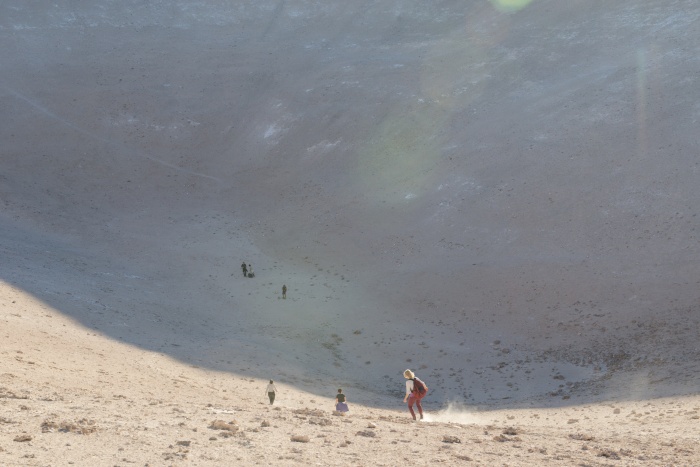
Badanie terenowe z uczestnikami SACO6, Quillagua, Dolina Meteorytów, 2017. (c) SACO
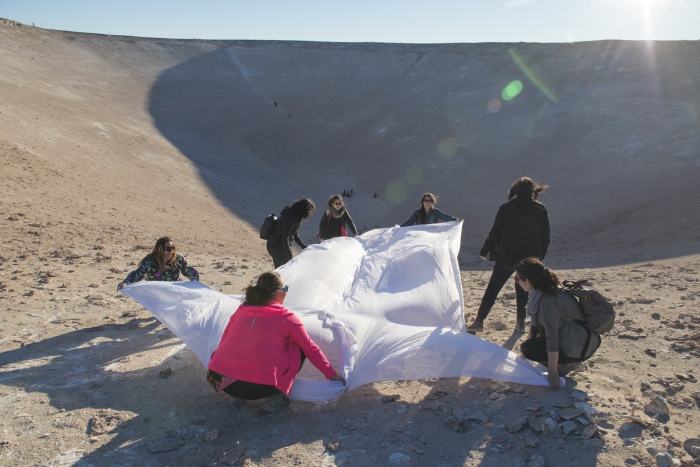
"Anónima", interwencja w przestrzeni otwartej, Ximena Zomosa, Dolina Meteorytów, Quillagua, Pustynia Atakama, Chile. Zdjęcie: Iñaki Uribarri, 2017. Dzięki uprzejmości artysty
MF: Listening to your story confronting that sort of Nothing you found in Antofagasta, culturally (of course), and considering everything you have generated in that landscape, somehow it makes me think of how much dialogue there must have been with the whole context of the extreme environment. Somehow you modified the context and the context also modified you. I would like to know what aspects of the cultural and social field in Antofagasta invited you to develop your task and what made you think it was possible to achieve this?
DW: I wouldn’t say invitation, more like provocation. It all made me think that it was not possible. And there is no more suitable landscape to generate something than nothing, the void. Between the most extreme cities of the south and the north of Chile there are 5061 kilometers; between the southernmost campus of the art school and the northernmost there are 958 kilometers. All the university schools of Visual Arts are concentrated in less than a fifth of the length of Chile, the specialized exhibition spaces as well as the archives. The inequality of access to artistic higher education and, therefore, the professional void had already extending for three generations, it all deepens the knowledge gap, leaving most of the creative potential of the north of Chile at the margins; a fact that just occurs due to the lack of resources and the distance. In this context, to create a crack, a fissure, became a challenge.
MF: I don’t know if you agree with me that recently there has been an emergence of projects which share elements both in the way they have emerged, the similarity of the organizers, and the regional dimension they acquire. Projects that promote changes in a broad sense of the terms “context” or “environment,” because they have an impact on the very contextual conditions of production and they also critically intervene in their habitat, in short, on the environment. What would you attribute that emergence to? Do you believe that new communication technologies favor networking on a regional scale? Or, on the contrary, would you consider it to be the growth of the art sector that has solved the issues of these local scenes?
DW: There were always artists that thought their place was in the forefront of the struggle. But my impression is that today more than ever there are battalions of artists gradually abandoning the field of creation, finding more encouragement (meaning?) in social, pedagogic, or environmental activism. We live in a post-positivistic epoch, where art for art’s sake is hard to argue for in front of the world, and even more, in front of oneself. I personally stand on the other side of the bridge, with the motto “liberate art from the yoke of political correctness and social usefulness.”
MF: Far-reaching projects never present initially as a programed whole or at least infrequently. I would like you to tell us how you started to mobilize the production, formation, circulation, and somehow, the eventual consumption of cultural goods. Tell me more about how these aspects developed, as well as the situation of the audience, considering the projects were open to public spaces, I’m particularly interested in the case of Quillagua, where the audiences are frankly different from those of the city.
DW: Chronologically, first came the need to meet each other and create a space for dialogue, or actually to answer the questions “what are you doing here?” and “what’s next?” That’s the origin of the first house and the first workshop, the first exhibition. Quite early on, it became apparent to us that if we didn’t educate, we wouldn’t be able to move forward, we would be locked within a hermetic circle. I began teaching at local universities and schools. On Saturdays, I would teach workshops for self-taught artists. I took on the curatorship of a multi-purpose hall, that I turned, for a year and a half, into an experimental space. We have designed projects for the permanent education of visual art teachers of the region, and training internships for local artists, linking art and territory. Today we work constantly with twelve high schools of the region. The artists that participate in our projects assume the commitment of giving their knowledge back to the local scene. It’s not about training artists, but developing critical thinking, to legitimize subjectivity, to propose a bit of content, and defeat the dictatorship of the instantaneous. We want people to demand art. And for this to happen, people must know it, and enjoy it. This is where we are at.
SACO is a turning point in the volume of our events. To establish a visual arts festival in an open space, in the historic city center, provoked an impressive boom of public attendance. And this means we have instilled interest. In the last edition of SACO, we reached almost fourteen thousand people, yes, and in this sense it is a more mainstream audience, but I rather see every visitor individually, without losing that approach.
Around 120 people live in Quillagua, mostly elders of Aymara descent, who refused to emigrate to the city and safeguarded the oasis. They are victims of several crimes against ecology and their health, they represent an example of resistance. Every year after the inauguration of SACO we take a trip to contextualize within the territory, open to everyone. We visit the site of geoglyphs, the Meteorite Valley, we watch the stars under the cleanest sky on the planet, we talk to the quillaguenses (Quillagua’s inhabitants), about topics such as the time, which runs differently there. In that context, we are the spectators, not them.
MF: How do you conceive of your curatorship? Do you think in terms of works, artists, discursive aspects? How do you do it? Do you agree with Justo Pastor Mellado that a curator in Latin America is a producer of infrastructure?
DW: The concept of curator is similar to that of the shaman. It’s not clear what is it about, but they are very attractive, someone who knows more, who connects, although some people say they don’t need them, that they set up an unnecessary hierarchy, that it’s all an exercise of the ego. Finally, each curator’s activity is what defines the field and its objectives.
Every space is potentially exhibitory. The exercises, both interior and exterior, of conversion and appropriation expand and democratize access to art, not only de-monopolizing the circuit of conventional museums and galleries, but above all enriching and diversifying the use and reading of urban spaces. These exercises also renew the way of speaking, circulating, and looking. Moreover, these artistic practices enter into a fresh and unique dialogue with the place and preserve a nomad autonomy, of incessant searching and reconsidering. The link with the deserts (the coast, the Pampas, pre-Andes) provide the events – those of research as well as those of creation and education – a universal character, at the level of the process and the experience.
At the museum without a museum, far from the palaces of 19th architecture –which establishes a distance with the citizen who is on the sidewalk – we can enter into a dialogue from any corner with the community and create flexible tours. We imagine and establish an exhibition circuit brought together by a curatorial project, with a formal coherence and a single way of thinking about art, the territory, and the public.
The most visible space of the museum without a museum is the Melbourne & Clark Historic Dock of Antofagasta, a patrimonial and symbolic construction, inscribed in the logic of Chile, a country lying down on its side, with its back to the mountains, and its knees in the water.
Another utopia that we put into practice, the school without a school, is related to pedagogic curatorship. An education platform, an ongoing space of knowledge exchange; of techniques; of critical-thinking development; of a generation of interdisciplinary connections; of linkage with the territory; of creation of human bonds through common work and goals; of dialogue, reflection, and reading. This is the standpoint from which I understand my role as the initiator of the local scene. From there, I also seek intersections with other areas. To listen from the sources of meaningful contents, which in the north of Chile are: astronomy, geology, or archeology, among other fields of knowledge, allows us to build really contemporary questions, transversal to the fields of research. At ISLA, we develop exchange programs with scientists, who nourish research by local artists as well as interns.
I don’t produce real infrastructure. But I have established a museum without a museum, an ephemeral building, a fictitious institution, a map that provides the city with a new reading and connects places where we make art. I produce texts that have nothing to do with the curatorial writing to which we are used to, I don’t come from the world of theory, but of artistic practice. And from that experience with art, I design invitations that I myself would like to receive. For example, in LOVE: Decadence and Resistance last year I invited people to reflect on the different layers of the sentimental revolution Latin America is undergoing today. This year’s Origin and Myth proposes a look at these different histories as a field for appropriation and creation.
MF: We have talked about Dagmara the manager and curator, but we haven’t talked about the artist. How do you feel this Chilean landscape has impacted your work? Where does the discursivity of your work aim and what are your references in the field of art?
DW: This landscape challenges you. It makes you feel insignificant. You feel your breathing, you understand that you are mostly made of water, that it is evaporating. That kind of seventh-grade biology begins to make sense, you understand it now. Walking alone through the desert you clearly realize why all the pre-Columbian religions of the Altiplano, the high plateaus of the Andes, venerated the Sun. The desert, on the contrary, is pure learning. It disarms you, it’s endless, it’s not made at human scale, there is no way to scratch it. Somehow, it’s a temple with no walls, allowing me to disconnect the irrelevant. Where the passing spontaneously separates from the transcendental. I address the body, I use people closest to me in my works. My most recent work is a set of copper jewelry, with my wisdom teeth, and the baby teeth of my children. I put tension on self-sufficiency by taking it to its extreme, but also the intransferable value of this kind of object. I’m interested in the symbolic factor of scale and distance. I’m fascinated by investigating our limits as a species, and also our great dreams and sources of pride; our aspirations and inconsistencies. Without any kind of self-definition, I’ve been inspired by my body on several occasions. If I weren’t an artist, it is likely that I would be a midwife. I’m interested in things that are not subject to speculations. I vibrate with the classic works of land art, they are like good old rock, some of my references are Hatum, Gordon Matta-Clark, Kapoor, Hofman, and Kantor.
MF: Some years ago, and especially since the environmental issues began to settle as a global problem, there has been a growing interest in the field of art in addressing these topics. What are your insights about the relationship between art and ecology in Latin American art?
DW: That art always loses when it carries the pretentious backpack of wanting to solve problems here and there. This is not its task. The thing here is not how relevant and pertinent are the environmental demands that move the continent today, this is not the issue. What is dangerous for the work is to commit itself to that kind of level. That transcendence is lost, as well as the possibility of a multiple reading, the absurd, humor, the atemporal, the abstract, the contradictory, and that only the skeleton of denunciation remains.
MF: Perhaps your fellow Poles are interested in what aspects of your culture of origin (Polish) you are projecting in Chile through your work.
DW: Oh, my! Culture of origin is a delicate topic in Polonia today. Through the prism of the Andes, we are an exotic country, where German or Russian is spoken, that suffered a lot during the war. Later, it fell behind the sofa and no one heard of it for half a century. Key concepts that we project are sacrifice, religion, workers’ dignity, the struggle for independence. The cashiers at the bank and public functionaries frequently ask me about the Pope. “He was the best,” they say.
Through my work I attempt to displace this projection towards rigorousness, coherence, consequence, and commitment, combined with the ability to see things as they are, and finding solutions from there. My constant questioning and criticism of the reality in which I live is no longer perceived, as it was at first, as a sign of arrogance, but as a tool that aims at contributing to change. At least, this is the feedback that I get now.
MF: Finally, and under the conviction that I never reply from the place you ask – paraphrasing Lacan – that is, that communication is an absolute, unreachable and in that sense of the limitations of alterity, beyond good intentions, I want to suggest an open question. Almost with the certainty that there were things we didn’t address. What would you like to talk about that I have not asked about?
DW: About love. About what made me stay here – and I’m certain of this – for good. I will reply with a fragment of the curatorial text from SACO6:
“Latin America is the land of a syncretism of affections. An officially Catholic continent, where most of the children are born out of wedlock, where original religions peacefully coexist with sin and guilt, and the patriotic climax is experienced not in an ideological debate, but by watching a soccer match. A culture stigmatized abroad because of the image of a Latin lover, a compulsive but irresistible polygamist, and its endless variants, cultural and sentimental clichés for export, such as the mariachi, an obsessive macho; the Caribbean black, the king of salsa; the impeccable and masculine tango dancer, among others. Several of these icons are believers and have children with several women, which remains in some parts a synonym for being a macho. The daughter of a sacrificed woman, from a mother who was abused and cheated on, leaves her home with no intention of forming her own, or at least not the traditional nest anymore. Alternative family structures appear. What yesterday was considered repulsive, today is frequently the new trend and attracts those who want to experiment, both spiritually and carnally. The conservative and the transgressive circles look at each other in disgust and with a bit of attraction at the same time. Sometimes looking leads to something else.
Perplexity is caused by the omnipresent coexistence of the affective world structured by patriarchy, today in clear decay, with the simultaneous explosion of freedom and diversity in the ways we relate and love. In hybrid social ecosystems, all kinds of love mutate: from that which bonds us to our closest ones and defines our immediate daily constellation, or the emotional identification with the territory we belong to, whether it is demarcated in the map, ideological or virtual, to that which evokes an afterlife, whether it’s religious, spiritual, pachamamic love, or the universe. Very accelerated transformative experiences allow us to think that we are facing a clearly Latin revolution, with no beheading or death by burning, although it is irreversible and transcendental.”
Translated from the Spanish by Pablo Abufom Silva
BIOS
Dagmara Wyskiel is a visual artist, the author of site-specific interventions, a performer, and curator and part of the artistic scene in Chile. She holds a PhD in Art from the University of Fine Arts in Cracow. She is the co-founder of the Collective SE SALES Mobile Platform of Contemporary Art and the artistic director of the SACO Week of Contemporary Art in Antofagasta. She was the main editor of the Chilean Triennial in 2009. She has conducted site-specific interventions and workshops in places such as the Valle de los Meteoritos in the Atacama Desert, the ALMA astronomical observatory, Lake Amargo in the Magallanes region, and in the Chilean Antarctica and many others. She has conducted several unique activities on salt pans in the Argentinean Andes, in public spaces in Manizales, Medellín, and Bogota in Colombia, London, and Castro in Chile. She has presented her works at exhibitions in the United States, China, Mexico, Uruguay, Indonesia, and Argentina. In 2016, she received the Grand Prix at the 17th Asian Biennale in Bangladesh.
Marcos Figueroa is a visual artist, independent curator, teacher, researcher, and architect. He lives and work in Tucuman Province, Argentina.
He is the CIUNT projects director for contemporary art and, as such, he has published articles on his area of specialization, has given lectures in Argentina, Spain, Chile, Bolivia, Brazil, and the United States. Every year in Tucuman, he organizes the International FORUMS of Contemporary Art and Cultural Policies. He founded and is the director of the ARCHIVE of contemporary art in Tucumán, Argentina, and he is the director of the FASE Foundation. He is also director and curator of the Foro/ARPO, International Forums of Art and Cultural Policies, in Tucumán, Argentina. He curated the Antofagasta Project for the Visual Arts Triennial in Chile (2009), where the chief curator was Ticio Escobar.
As an artist, he has exhibited in Argentina and abroad, and has received several important awards: the First Drawing Award at the 41st Tucuman National Salon of the Fine Arts Provincial Museum (2012); the 2nd Award of the 7th National Painting Salon of the Central Bank (2013), and the Cultural Equality Award (2013). He was also invited to the 8th Biennial of Bolivia in 2013 and 2016.
Since 1986, he has been the director of Workshop C of the School of Art at the Universidad Nacional de Tucumán, where he coordinated the Clinics for young artists of the NOA (1995–1996), sponsored by Fundación Antorchas. He was the Dean of the School of Arts at the UNT in 1999–2002 and 2002–2006. He can be reached at: taller-c@live.com.ar
* Cover photo: Field work with SACO7 participants, Quillagua, Meteorite Valley, 2017. (c) SACO



